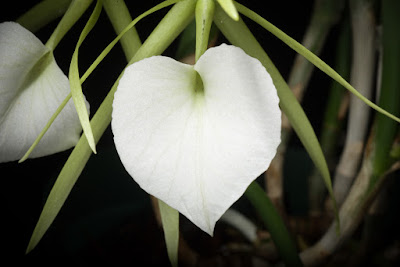Brassavola nodosa is native to Mexico, Central America, Colombia and Venezuela. This species grows in Mexico, along the Gulf Coast of Mexico, south of Tampico, but these plants are also found on the Pacific coast of Chiapas...
Brassavola nodosa also called as The Knobby Brassavola, Lady of the Night, Bletia nodosa, Bletia rhopalorrhachis, Brassavola grandiflora, Cymbidium nodosum, Epidendrum nodosum, is a species of the genus Brassavola. This species was described by John Lindley in 1831.
IDENTIFY BRASSAVOLA NODOSA
Brassavola nodosa is native to Mexico, Central America, Colombia and Venezuela. This species grows in Mexico, along the Gulf Coast of Mexico, south of Tampico, but these plants are also found on the Pacific coast of Chiapas. Their habitat stretches southward through Central America, along the coasts of both the Pacific and the Caribbean, reaching northern Venezuela and Colombia. This species were also found on the islands of West Indies. These plants are found in low-lying coastal regions, below 500m, as growing on trees in lowland rainforests and mangrove swamps or on rocks and cliffs near the coast.
The Knobby Brassavola is a medium sized, hot growing epiphyte or lithophyte, which can reach a height of 38-46 cm, with cylindrical, short, up to 15 cm long stems enveloped by scarious sheaths with a single, sub-terete, sulcate, acute-apiculate, 10-30 cm long and 0.3-1.8 cm wide leaf.
Lady of the Night has a nice, citrus fragrance at night and the flowers are close to 4" across and occur in the spring and summer but are possible at any time of the year on a 20 cm long, bracteate inflorescence that arises on a newly maturing pseudobulb that carries a single, long, sub-terete leaf that carries up to 6 flowers. The flowers are usually about 9 cm in diameter, but they can reach as much as 15 cm. Perianth lobes are elongated, slender, do not break down too widely, and can be from light green, pale yellow to almost pure white. The large lip has the shape of the tube at the base, then opens wide to form a heart shaped end surface that can reach as much as 5 cm in diameter. The lip is white and often mottled with purple or dark red spots.
BRASSAVOLA NODOSA CARE AND CULTURE
Cultural information should only be used as a guide, and should be to be adapted to suit you. Your physical location; where you grow your plants, how much time you have to devote to their care, and many other factors, will need to be taken into account. Only then can you decide on the cultural methods that best suit you and your plants.
Light:
Brassavola nodosa needs a light level of 25000-35000 lux. These plants are able to tolerate higher light intensity if they are gradually accustomed to it. When the light intensity is higher, you need to ensure high humidity and significant air movement. To avoid burns, you also need to ensure that water does not remain on the leaves during the strongest sunshine.
Temperature:
It is a thermophilic plant. The average temperature in the summer at 31 °C, at night 23-24 °C, with a daily difference of 7 °C. The average winter temperature is in the day 25-26 °C, at night 17 °C, the daily difference is 6 °C.
Humidity:
Lady of the Night needs the humidity of about 80% throughout the year.
Substrate, growing media and repotting:
Brassavola nodosa with high demands on irrigation during the growth period require the use of a very loose, well-permeable substrate, eg pine bark, pieces of cork or tree fern fibers with medium or high gradation. Small pots should be used so that the roots only fit and take place for about two years.
Repotting should be performed when new roots start growing or immediately after flowering. The plants can be attached to cork sheets or tree ferns, as long as we can provide high humidity and watering at least once a day during the summer.
Watering:
The cultivated plants should undergo at least a two-week period of drought, so that the growth mature and to stimulate flowering. In the period of strong growth, the plants needs abundant watering and the growing medium should be moist. Watering every 2-3 days during the hottest and the brightest period of the year corresponds to the conditions of most natural habitats.
Fertilizer:
During the period of strong growth, the plants should be fertilized every week with 1/4-1/2 of the recommended dose of fertilizer for orchids. You can use fertilizer with low nitrogen content and high phosphorus content in autumn. It improves flowering in the next season and strengthens new growth before winter.
Every few weeks, the substrate should be flushed to avoid the formation of mineral deposits, especially when high doses of fertilizers are used, it is necessary to normally water the plants to dissolve the accumulated salts After about an hour the substrate should be rinsed with water equal to twice the volume of the container, rinsing throughout the whole year is important especially where the water is highly mineralized.
Rest period:
During winter, watering for Brassavola nodosa should be reduced, but dryness should not be allowed. In most cases, such conditions can provide morning fogging combined with very light watering every 2-3 weeks, especially when sunny weather is expected. During this period, the fertilization should be reduced or completely stopped.















COMMENTS